Chimney pots are an elegant and practical way to enhance your home’s exterior. These tapered terra cotta structures, originally designed to improve draft, have decorated American residential chimneys since the 19th century. Today, homeowners can choose from many shapes, styles, and sizes to complement their home’s architecture. Whether you’re looking to add historical charm to your chimney or improve your fireplace’s functionality, chimney pots offer an affordable and easy-to-install solution.
What Are Chimney Pots?
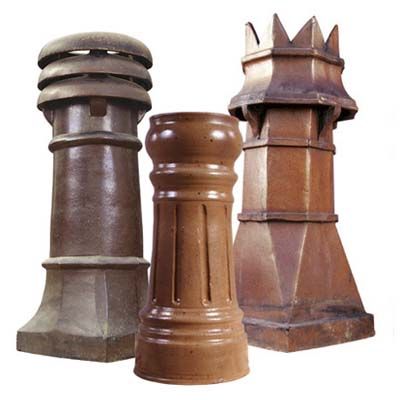
Terra cotta chimney pots can withstand extreme heat from chimney fires and last for centuries. Unlike metal chimney caps, ceramic pots don’t attract lightning, providing a safety benefit. They may also improve your fireplace’s performance by reducing smoke backflow into your living space. Installation is simple, requiring only a few hours, some basic tools, and a bag of mortar.
Chimney pots often have intriguing names that reflect their shapes, origins, or both. Examples include the Leeds Three Bowl, the Cannon Barrel, and the Halifax Tulip Top Windguard. You can find inspiration for a chimney pot design that suits your home, from modern to whimsical, in our guide below.
Chimney Pot Considerations
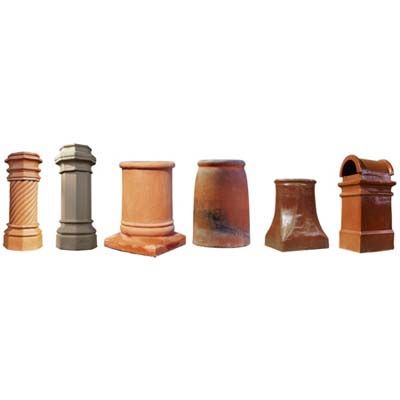
The modern chimney pot market offers both new and antique styles. With hundreds of options available, homeowners can find the perfect match for nearly any architectural style. New chimney pots often feature updated designs that blend traditional aesthetics with modern functionality. Antique pots can add authentic period charm to older homes or historically-inspired new builds.
Before we dive into designs, keep these factors in mind for choosing a chimney pot:
- The size and shape of your existing chimney: Ensure that the chimney pot fits the dimensions of your chimney. A pot that’s too large can overwhelm the chimney, leading to poor draft performance and potential structural strain. A pot that’s too small may restrict airflow, reducing the efficiency of your chimney and potentially causing smoke to back up into your home.
- Your home’s architectural style: Choose a chimney pot that complements your home’s design, whether it’s traditional, modern, or somewhere in between. You don’t want your chimney pot to overwhelm the architecture—if the pot is too large, it can dwarf your home and disrupt the visual balance.
- Local building codes and regulations: Check with local authorities to ensure your chosen chimney pot complies with regulations. This will help you avoid fines or the need for expensive modifications after installation.
- The pot’s intended function (decorative, functional, or both): Decide whether the chimney pot is for aesthetic purposes, improving draft efficiency, or a combination of both. This will guide your selection of design and features.
- Material and finish options: Terra cotta is a durable and traditional material that offers a classic look. You can choose from finishes such as glazed, unglazed, or colored terra cotta. Glazed finishes provide a smooth, shiny surface that is more resistant to water and staining, while unglazed options have a more rustic, natural appearance. Colored finishes allow for additional customization to match or contrast with your home’s exterior.
- Maintenance requirements: Intricate designs may require more frequent cleaning to maintain both their appearance and function. Simpler designs are easier to upkeep, but you should still periodically inspect the mortar to ensure longevity.
- Regional considerations: Consider the climate and environmental factors in your area when selecting a chimney pot. In regions with high winds, you may need a heavier chimney pot to prevent damage or displacement. Consult professionals who can provide insights on the best fit for your chimney and regional climate conditions.
The Leeds Style Chimney Pots
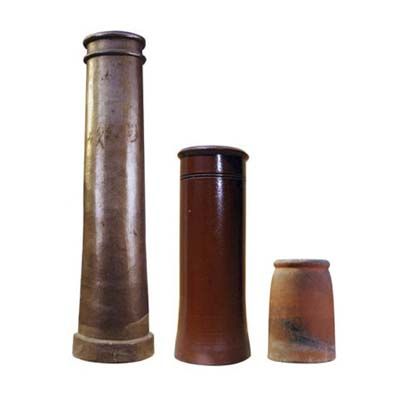
Leeds-style chimney pots offer a range of sizes to suit various needs, from the towering 58-inch antique Leeds Roll Top to the modest 18-inch Leeds Beehive. The rounded shaft typical of Leeds-area chimney pots adds a distinctive touch to any roofline. A Leeds chimney pot can add a touch of English charm to your home and is a good choice for homeowners looking to maintain historical accuracy in their architectural features.
The Pittsburgh Octagon Chimney Pots
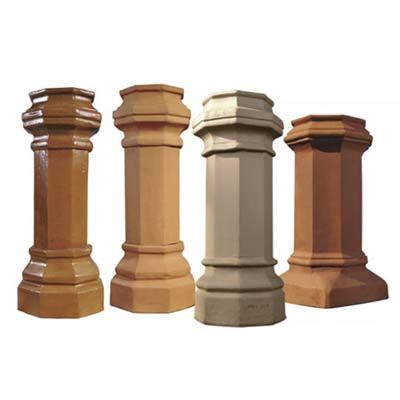
The Pittsburgh Octagon is one of the most popular chimney pot styles in America. Its clean lines and geometric shape make it a versatile choice for a wide range of architectural styles. Available in various finishes, including glazed, red, and buff, the Pittsburgh Octagon can be customized to complement your home’s exterior color scheme.
Large Chimney Pots
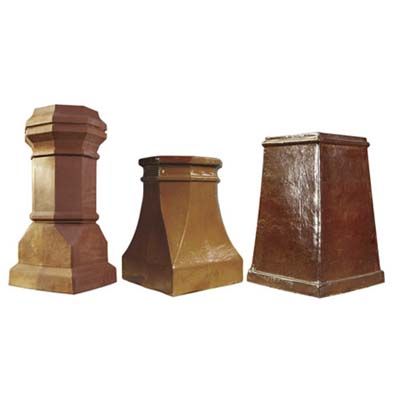
Modern homes often feature larger chimneys and flues, which require correspondingly larger chimney pots. Extra-large options like the Jumbo American E, the Stafford Magnum, and the Magnum Windsor are designed to meet these needs. Some magnum chimney pots reach heights of up to six feet and can accommodate flues over two feet wide.
When choosing a large chimney pot, keep in mind the structural capacity of your chimney and roof and the visual impact on your home’s overall proportions. Consider hiring professional help for the installation of heavier pots.
Antique Chimney Pot Beauties
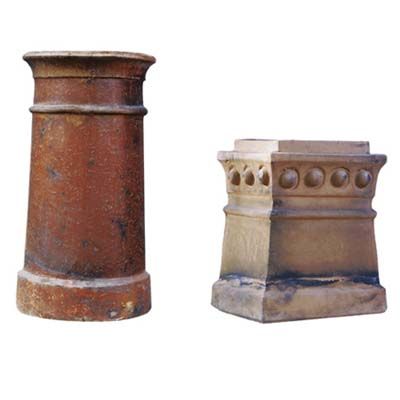
Antique chimney pots can add instant character and authenticity to period-style homes or restorations. The aged patina of these vintage pieces tells a story and can create a sense of history even on newer constructions. Before installing a vintage chimney pot, verify the pot’s structural integrity and check for any cracks or damage that could compromise safety. We recommend having a professional chimney sweep or mason inspect the pot before installation.
Chimney Pots With Dragons on the Rooftop
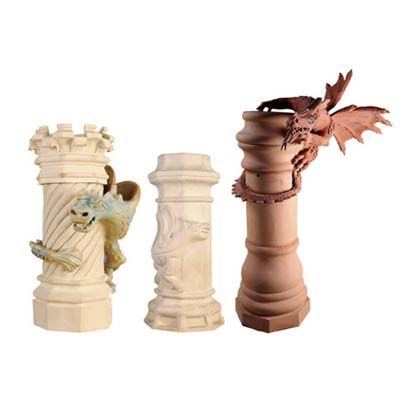
If you want a dramatic statement, dragon-themed chimney pots offer a unique and eye-catching option. These custom designs range from subtle to severe, with some standing nearly 6 feet tall. The Dragon Guardian chimney pot, for example, makes an imposing addition to any roofline. Some designs incorporate whimsical functional elements, such as smoke emanating from the dragon’s mouth.
When selecting a dragon-themed chimney pot, consider the overall architectural style of your home and the statement you want to make. While a bold design can be a conversation starter, you want it to complement rather than overwhelm your home’s aesthetic.
Candy Land Chimney Pots
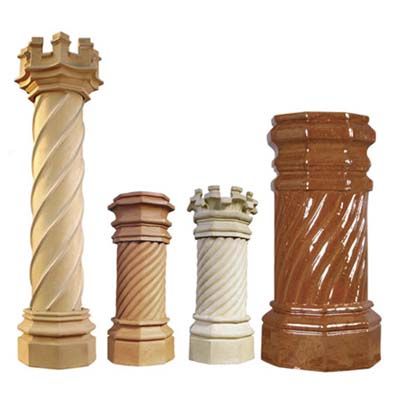
Chimney pots with castellated tops and candy twist shafts showcase the artistry and craftsmanship available in modern designs. These unique elements add visual interest and can become a defining feature of your home’s roofline. When opting for ornate designs like candy twists or castellated tops, consider the overall scale of your home and chimney and the visual weight of the design in relation to your roof.
Mix and Match Chimney Pots
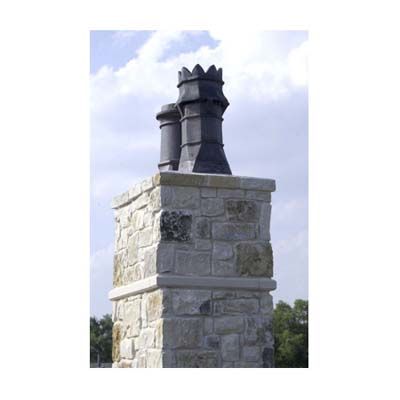
One of the joys of selecting chimney pots is the freedom to mix and match styles. As demonstrated by the mismatched Victorian-era chimney pots in the image above, combining different designs can add visual interest to your home’s exterior.
When mixing chimney pot styles, consider the overall balance and proportion of the grouped pots and how the different styles complement each other and your home’s architecture. Also, check the functional requirements of each flue.
Rain Protection for Chimney Pots
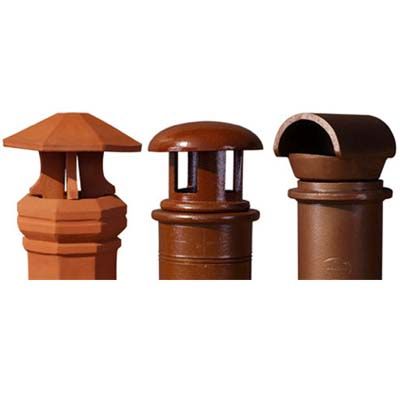
In rainy climates, you want your chimney pot to feature additional protection against rain. You can opt for a matching terra cotta rain guard. These protective accessories are available in various styles and can be paired with most new chimney pots, as well as some antique models.
How To Visualize Chimney Pot Installations
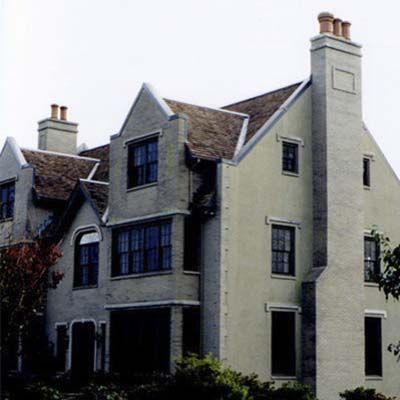
Chimney pots can dramatically alter the appearance and character of a house. The beefy, octagonal chimney pots chosen for this home create a sense of strength and solidity. In contrast, smaller, rounded pots can lend a more inviting and cozy atmosphere. When selecting chimney pots, consider how their shape, size, and style will interact with your home’s overall aesthetic.
You can visualize the impact of different chimney pot styles by using photo editing software to superimpose various pot designs on an image of your home or by creating cardboard mockups to test different sizes and shapes. Visit homes in your area with similar architectural styles to see chimney pots in action, and consult with a design professional or chimney specialist for expert advice.
How To Retire a Chimney
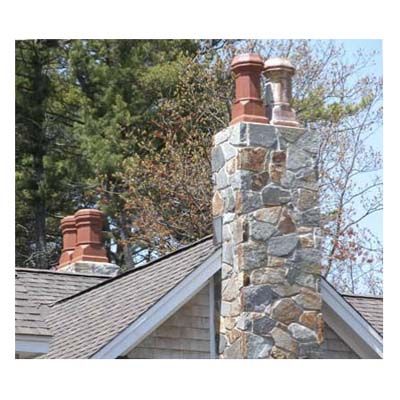
Even when a chimney is no longer in use, it can still serve as an architectural feature. Retired chimneys can be capped with decorative chimney pots to maintain the home’s curb appeal. This approach allows homeowners to preserve the character of their property while addressing practical concerns related to unused flues.
When retiring a chimney with decorative pots, ensure the chimney is properly sealed to prevent moisture intrusion. Use a lightweight replica if structural support is a concern, and consult with a chimney professional to ensure the installation meets safety standards.
How To Keep Critters Out of Your Chimney
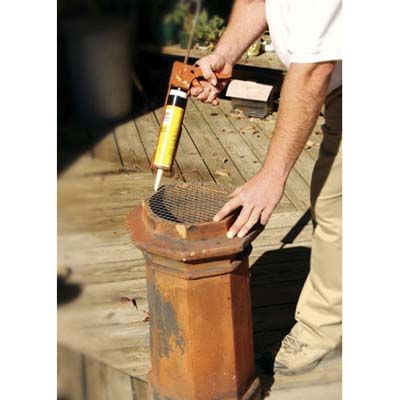
To prevent leaves, debris, and animals from entering your flue, a simple and effective solution is to attach a small piece of metal screen to the top of your chimney pot with a bead of silicone caulk before installation. Some mesh sizes may serve as a spark arrestor, providing an additional safety benefit.
When installing a protective screen, choose a mesh size that balances protection with ventilation and ensure the screen material is compatible with high temperatures. Clean the screen regularly to maintain optimal airflow. Consider professional installation if you’re unsure about the right techniques.
Installing Your Chimney Pot
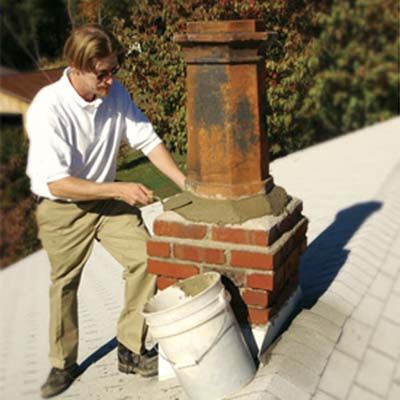
Installing a chimney pot is a relatively straightforward process that requires basic tools and materials. The key components needed are mortar and a few common household tools like a trowel for spreading the mortar and a ladder to access your roof.
Ensure your chimney is in good condition without cracks or damaged mortar before adding a chimney pot. Choose a calm, dry day for the installation and follow the manufacturer’s guidelines. Hire a professional if you’re uncomfortable working at heights. Check the mortar every 10 years or during routine chimney sweeping to ensure the pot remains securely in place.
